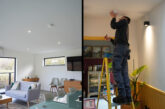
In this regular column, ‘Dr Zzeus’ Tom Brookes, MD of Zzeus Training and chairman of the FSA, answers your questions related to fire safety compliance.
Q. We keep getting false alarms in hotel bedrooms, usually caused by steam or deodorants/hairsprays. The fire service is now threatening the hotel with being in special measures. What should we do?
Fire alarms are a crucial component of any building’s safety infrastructure, providing early warnings in the event of a fire outbreak and saving lives. However, the issue of false alarms has been a persistent challenge in the UK and around the world.
False alarms cause unnecessary panic and disruption and strain emergency services and resources. Recent estimates are that false alarms cost around £1 billion a year.
The causes of false alarms can be diverse, ranging from cooking fumes and steam to dust particles and faulty sensors. Such incidents lead to a reduction in trust in fire alarm systems and an overall complacency in responding to alarms, which can have dire consequences when a real fire emergency occurs.
How do we ensure that a hotel bedroom has suitable coverage while keeping false alarms to a minimum?
The standard smoke detector looks at smoke particles, but it will often mistake steam and dust as smoke and activate as a fire. My first step is to check if the detector is sited suitably away from the bathroom door. Bad positioning regularly causes false alarms.
A call-out engineer who is under pressure will often choose to install a heat detector that may cure the false alarm problem but will reduce the effectiveness of detecting a smouldering fire. If someone is sleeping very deeply, they would most likely succumb to smoke inhalation before the temperature in the room is sufficient to activate a heat detector. By installing a heat detector in a hotel bedroom you’re taking the risk that the occupant of the room of fire origin may not survive.
In recent years, multi-sensor detectors have emerged as a promising solution to mitigate the problem of false alarms, enhancing the reliability and effectiveness of fire alarm systems. Unlike their single-sensor counterparts, multi-sensor detectors employ a combination of sensing technologies, such as heat, smoke, and Carbon Monoxide detection, to provide a more accurate analysis of the environment.
How do multi-sensor detectors work?
These detectors use a multi-pronged approach to analyse the air for signs of fire. They’re designed to differentiate between actual fire-related particles and common sources of false alarms like cooking fumes or dust. When a multi-sensor detector senses both an increase in heat and the presence of smoke particles, it’s more likely to trigger an alarm. This dual confirmation mechanism significantly reduces the chances of false alarms caused by non-fire sources.
Some may recommend Carbon Monoxide detectors, which would cut down on false alarms from steam etc. However, if it were a fast-flaming fire, a CO detector wouldn’t pick it up effectively.
Over the last few years, ZZEUS Training has spent time with Apollo Fire Detectors, understanding how multi-sensor detection works. One of my favourites to help eliminate false alarms in hotel bedrooms is Apollo’s Discovery Carbon Monoxide (CO)/heat multi-sensor detector, which provides early warning of fire by detecting the presence of CO or heat, or a combination of both.
We’ve seen this detector in the Apollo test labs, and it effectively reduces false alarms whilst still providing a detection time of 20 seconds in multi-sensor mode.

Multi-sensor CO and heat detectors provide a much safer option than a heat-only detector, and will offer early warning of carbon-based smouldering fires; good detection of flaming fires; ideal protection for small-volume sleeping risk areas; and resistance to false alarms caused by steam, dirt, and dust.
Special thanks to Jessica Mann at Apollo Fire Detectors for her help with this article.
Do you have a question you’d like answered? Email your queries to: Tom@Zzeus.org.uk









